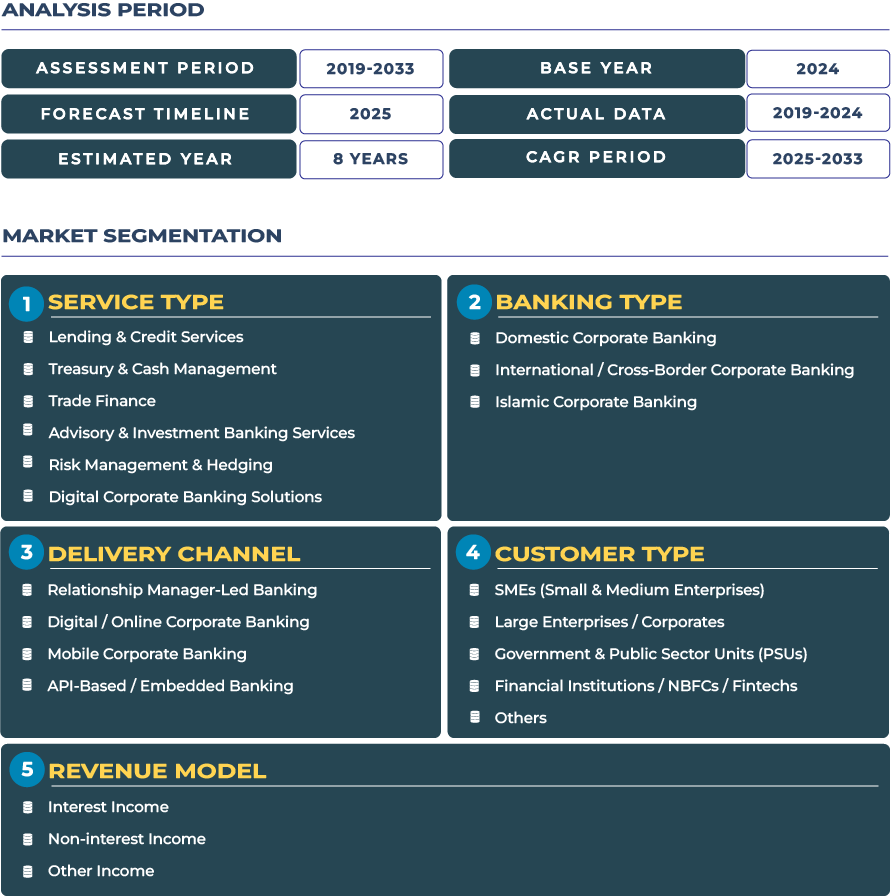Mid-Market Corporate Banking in Italy: Customized Solutions Powering SME and Mid-Sized Enterprises
Italy corporate banking market is entering a transformative phase, fueled by mid-market enterprises seeking tailored financing, digital cash management, and specialized advisory services. These mid-sized and family-owned businesses form the backbone of Italy’s industrial fabric, particularly in regions like Lombardy, Emilia-Romagna, and Veneto, and require dynamic financial structures to manage succession, liquidity, and expansion in an increasingly competitive European market. Italian banks are adapting their corporate banking strategies to serve this segment with bespoke solutions in treasury management, trade finance, and structured credit.
Note:* The market size refers to the total revenue generated by banks through interest income, non-interest income, and other ancillary sources.
The Italy Corporate Banking Market was valued at USD 58.4 billion in 2025 and is projected to reach USD 75.5 billion by 2033, expanding at a CAGR of 3.3%. This steady growth reflects the nation’s resilient economic framework and renewed investment appetite among corporate clients. The recovery of Italy’s manufacturing base, ongoing digitalization of financial systems, and the gradual strengthening of capital adequacy ratios have collectively positioned Italy corporate banking industry for sustainable expansion over the long term.
Resilient Drivers Fueling Growth Across Italy Corporate Banking Ecosystem
The resurgence of Italy’s manufacturing clusters, particularly in automotive components, textiles, and precision engineering, has intensified the demand for supply-chain financing. Corporate banks are increasingly offering dynamic discounting and receivables financing structures that optimize liquidity within these regional industrial ecosystems. For instance, Milan-based banks are piloting blockchain-enabled trade finance tools to enhance transparency and mitigate operational risks across complex supply networks.
Italy’s family-owned enterprises, which account for nearly 85% of private companies, continue to rely on corporate banks for succession financing and ownership transition advisory. These institutions are designing hybrid lending products that combine equity-linked capital with advisory solutions, ensuring generational continuity and stability in ownership. Additionally, the tourism and hospitality sectors, cornerstones of Italy’s service economy, are witnessing a renewed appetite for credit as hotels and resorts modernize post-pandemic operations, often supported through long-term loan syndications and green renovation financing packages.
Challenges in Italy Corporate Banking Sector: Navigating Legacy NPLs and Digital Fragmentation
Despite structural improvements, legacy challenges continue to weigh on the corporate banking landscape. High non-performing loan (NPL) ratios in certain mid-tier banks have constrained risk appetite, particularly among regional financial institutions. This limitation has slowed credit distribution to emerging SMEs and reduced flexibility in underwriting non-traditional borrowers. Moreover, fragmented banking operations across Italy’s regions create inefficiencies, with differing risk models, compliance standards, and digital maturity levels.
Another major restraint lies in the slow digital transformation among SMEs. Many mid-market firms still rely on manual treasury processes and limited data integration, hindering the scalability of digital corporate banking solutions. Although Italian banks such as Intesa Sanpaolo and UniCredit are driving strong digitization initiatives, adoption remains uneven. Overcoming these barriers will require broader collaboration with fintech ecosystems, targeted policy support, and increased investment in SME financial literacy programs.
Emerging Trends and Opportunities Shaping Italy Corporate Banking Landscape
One of the most transformative trends in Italy corporate banking industry is the rise of regional cash pooling across industrial districts. These structures enable large groups with multiple subsidiaries to optimize liquidity management through centralized cash visibility, improving working capital efficiency. This trend is particularly strong in manufacturing-intensive northern Italy, where multi-entity groups leverage real-time treasury dashboards and AI-driven forecasting tools.
In parallel, fintech-driven lending platforms are emerging as strategic allies for banks aiming to extend SME reach without increasing credit exposure. Partnerships between traditional banks and fintech firms are enabling agile disbursements, risk scoring, and trade credit solutions. Another growing trend is the expansion of green renovation financing across Italy’s hospitality and tourism infrastructure, an initiative supported by Italy’s National Recovery and Resilience Plan (NRRP). Corporate banks are structuring ESG-linked loans that reward sustainability compliance and green certification among borrowers.
Opportunities are also expanding in digital supply-chain finance, particularly for export-oriented manufacturing districts. The increasing integration of real-time payment systems with supply-chain data creates new efficiencies and lower financing costs. Furthermore, succession-linked advisory services and green retrofit financing are gaining traction, offering banks new revenue streams while supporting national economic renewal and sustainable development.
Competitive Landscape: Strategic Alliances and Product Diversification Define Market Leadership
Italy corporate banking sector is witnessing intensified competition among leading domestic and international players. Institutions such as Intesa Sanpaolo, UniCredit, and Banca Monte dei Paschi di Siena are actively expanding their corporate product portfolios to target SME and mid-market clients through tailored working capital and trade finance offerings. Recent developments include Intesa Sanpaolo’s 2025 initiative to strengthen green lending channels for industrial clients and UniCredit’s digital trade finance expansion across Central and Southern Italy.
Moreover, banks are diversifying their strategies by targeting industrial district supply-chain finance, offering succession and shareholder loans, and launching green retrofit programs for hospitality and real estate. These targeted moves not only deepen client relationships but also position banks as long-term strategic partners in corporate resilience. The entry of foreign institutions, such as BNP Paribas and HSBC, further amplifies competitive dynamics, compelling Italian banks to accelerate innovation and strengthen their risk analytics capabilities.







